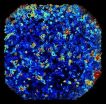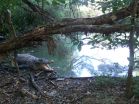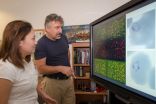(Press-News.org) How birds evolved to have characteristics including feathers, flight and song is revealed with new clarity in a major study of their family tree.
The international study charts a burst of evolution that took place after the mass extinction of dinosaurs, 66 million years ago. This step-change gave rise to nearly all of the species of birds that we see on the planet today - more than 10,000 varieties.
The four-year project - which included researchers from the University of Edinburgh's Roslin Institute - decoded and compared the entire genetic fingerprint of 48 bird species.
Species were selected from all major groups of modern birds - including the woodpecker, owl, penguin, hummingbird and flamingo.
The major study provides fresh insights into how bird genes differ from those of mammals, and the biological mechanisms that give rise to the vast diversity among birds.
Researchers compared the genomes of the 48 bird species with those of three other reptile species and humans. This enabled them to investigate at which point in each species' history specialised characteristics developed, such as feathers, flight and song.
They found that birdsong evolved independently at least twice. Parrots and songbirds gained the ability to learn and mimic vocal activity independently of hummingbirds, despite sharing many of the same genes. This is surprising because animals with similar characteristics usually share a common ancestor.
The findings are important because some of brain processes that are involved in bird singing are also associated with human speech production.
Birds are the most geographically diverse group of land animals. They help scientists investigate fundamental questions in biology and ecology and they are also a major global food resource, providing meat and eggs.
More than 200 scientists contributed to the Avian Phylogenomics Project, which was led by BGI (China), University of Copenhagen, Duke University, the Howard Hughes Medical Institute and the Natural History Museum of Denmark.
The findings are published in 23 scientific papers, including eight in the journal Science.
Building on this research, scientists at the National Avian Research Facility in Edinburgh have created 48 open access databases to share and expand on the information associated with the birds' genomes. They hope that researchers from around the world will continue to upload their own data, offering further insights to the genetics of modern birds.
Such information will be useful for helping scientists to understand why infectious diseases, such as bird flu, affect some species but not others.
Professor David Burt, Acting Director of the National Avian Research Facility at the University of Edinburgh's Roslin Institute, said: "This is just the beginning. We hope that giving people the tools to explore this wealth of bird gene information in one place will stimulate further research.
"Ultimately, we hope the research will bring important insights to help improve the health and welfare of wild and farmed birds."
INFORMATION:
The Roslin Institute receives strategic funding from the Biotechnology and Biological Sciences Research Council (BBSRC). The National Avian Research Facility, which is based at the Roslin Institute, is supported by the University of Edinburgh, BBSRC, Wellcome Trust and Roslin Foundation.
Two penguin genomes have been sequenced and analyzed for the first time in the open access, open data journal GigaScience. Timely for the holiday season, the study reveals insights into how these birds have been able to adapt to the cold and hostile Antarctic environment.
Antarctic penguins are subject to extremely low temperatures, high winds, and profound changes in daylight. They have developed complicated biological systems to regulate temperature and store energy for long-term fasting. Most studies have focused on the physiological and behavioral aspects of their ...
DURHAM, N.C. -- His office is filled with all sorts of bird books, but Duke neuroscientist Erich Jarvis didn't become an expert on the avian family tree because of any particular interest in our feathered friends. Rather, it was his fascination with how the human brain understands and reproduces speech that brought him to the birds.
"We've known for many years that the singing behavior of birds is similar to speech in humans -- not identical, but similar -- and that the brain circuitry is similar, too," said Jarvis, an associate professor of neurobiology at the Duke ...
VIDEO:
A microscopy system continuously measures responses to signaling chemicals in thousands of cells at a time.
Click here for more information.
Scientists have discovered a general principle for how cells could accurately transmit chemical signals despite high levels of noise in the system, they report in Science this week.
A cell's response to outside chemical signals depends on its physiological state, which can fluctuate considerably. Amounts of different kinds ...
The entire semiconductor industry, not to mention Silicon Valley, is built on the propensity of electrons in silicon to get kicked out of their atomic shells and become free. These mobile electrons are routed and switched though transistors, carrying the digital information that characterizes our age.
An international team of physicists and chemists based at the University of California, Berkeley, has for the first time taken snapshots of this ephemeral event using attosecond pulses of soft x-ray light lasting only a few billionths of a billionth of a second.
While ...
CHAMPAIGN, Ill. - Where did the songbird get its song? What branch of the bird family tree is closer to the flamingo - the heron or the sparrow?
These questions seem simple, but are actually difficult for geneticists to answer. A new, sophisticated statistical technique developed by researchers at the University of Illinois and the University of Texas at Austin can help researchers construct more accurate species trees detailing the lineage of genes and the relationships between species.
The method, called statistical binning, was used in the Avian Phylogenetics Project, ...
This news release is available in Spanish. 66 million years ago, the dinosaurs, as we think about them, became extinct, but certain reptiles and birds survived this mass extinction. The birds that survived experienced rapid evolution and diversification. Until now, explaining the family tree of modern birds has been a difficult and controversial subject amongst scientists. Thanks to the research of an international consortium involving researchers from the Centre for Genomic Regulation in Barcelona, we now have new clues about this evolution and further information ...
FORT LAUDERDALE-DAVIE, Fla. - We all know that ducks, crows, falcons and egrets are birds. A group of scientists, however, wanted to dig deeper and unlock more about how these animals are related genetically. The idea was to investigate how modern species of birds emerged and evolved after the dinosaurs disappeared from the earth. This research included work from Stephen O'Brien, Ph.D., a professor at NSU's Oceanographic Center whose main focus in genomics.
Now findings from this research are being announced in several scientific publications, including Science magazine, ...
A Texas Tech University biologist led a team of more than 50 scientists who mapped the genomes of three crocodilians.
By mapping these genomes, scientists may better understand the evolution of birds, which are the toothy predators' closest living relatives, said David Ray, an associate professor of biology. The team completed genomes of a crocodile, an alligator and a true gharial to complete the genomic family portrait.
Their research, largely funded by the National Science Foundation, will appear Friday (Dec. 12) in the peer-reviewed journal, Science.
"One of the ...
Scientists from Nanyang Technological University (NTU) have discovered exactly how the malaria parasite is developing resistance towards the most important front-line drugs used to treat the disease.
Malaria is a mosquito-borne parasite which affects over 60 million people worldwide and in serious cases, can be fatal. There is currently no viable vaccine for malaria while antimalarial drugs and prophylaxis are losing its efficacy with increasing drug resistance.
NTU Associate Professor Zbynek Bozdech, who led an international research team from 11 different countries, ...
The first findings of the Avian Phylogenomics Consortium are being reported nearly simultaneously in 28 papers -- eight papers in a Dec. 12 special issue of Science and 20 more in Genome Biology, GigaScience and other journals. The full set of papers in Science and other journals can be accessed at avian.genomics.cn
Scientists already knew that the birds who survived the mass extinction experienced a rapid burst of evolution. But the family tree of modern birds has confused biologists for centuries and the molecular details of how birds arrived at the spectacular biodiversity ...



